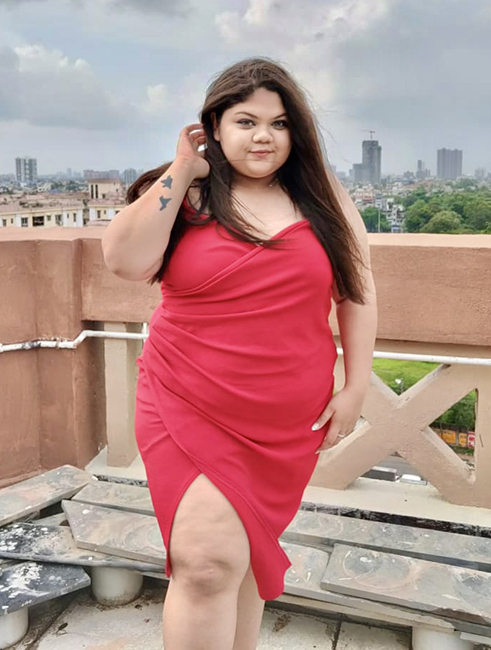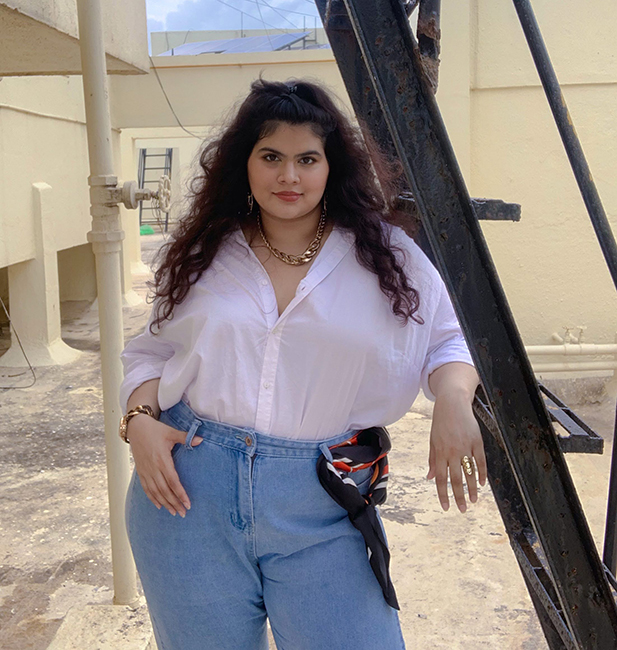
I'm jealous of Gen Z's confidence when it comes to how they dress
The body positivity movement may have picked up steam with millenials, but it’s a lived experience for the next gen
The year is 2002. Christina Aguilera’s Dirrty music video has caused a scandal. We clumsily paint chunky highlights onto our hair and fasten our extra-broad belts before taking grainy pictures on a flip phone. An ocean of midriffs flaunt low-rise jeans. Well, the ones who can fit into them at least.
Life was simpler, more innocent, as garishly coloured as our unicorn-themed MySpace pages. The only ‘social media’ apart from that was MSN Messenger and Hi5, before Facebook become a home for countless albums of unflattering flash photographs from every night we went out.
I can’t think of many early aughts trends that I hopped onto. A request to wear sweatpants with the word ‘juicy’ across my bum would probably have been answered with a thappad. But the trends of my youth are back with a vengeance, thanks to Gen Z. On Instagram, you’ll spot one influencer after another in uniform – baggy jeans, chunky sneakers, tiny sunglasses and tinier purses. Two strands of hair pulled out of slick ponytails, framing the face.
I hold a grudge against them for exterminating full-sized t-shirts and having them replaced with cropped tops. But underneath my disdain for Gen Z fashion, I realised, was envy.
There were a brief few months in 2016 when I threw caution to the wind and felt the breeze on my midriff. It wasn’t a burst of self-love that drove the choice to wear a crop top; I just finally felt that my stomach was flat enough. It didn’t last long. One glimpse of my belly while taking a spontaneous photo, and those tops made their way to the back of my closet. They’ve since been turned into jhaadans.
Meanwhile, I see around me a self-assured generation wearing what they want, when they want.
“You wear whatever you feel good in, without worrying about what this aunty will say or that neighbour uncle thinks,” says Annesha Chowdhury, 21-year-old Tweak intern and freelance model. “Be it someone curvy wearing a crop top or me, being petite, wearing something skintight which would make my frame more prominent.”
Barely an adult, she’s already wisened up to social hypocrisy that dictates how we access fashion. “If you’re plus-size they’ll say, ‘You only eat, don’t you work out?’ If you’re too skinny, it’s, ‘Ghar pe khana nahi milta? Eventually, we realised there’s no pleasing anyone, so you might as well do and wear what you want.”
Cue me, crying in my skinny jeans in Delhi summers.
Gen Z fashion is a peculiar mix of oversized comfort and in-your-face sexiness. Baggy pants obscure hips and thighs, but they’re paired with cropped tops and strapless corsets. And this isn’t a Friday club look either, you’re likely to spot them at the mall on a Sunday afternoon.
“People see clothes for what they are, just fabric. It doesn’t belong to one body type.”
“As recently as 4-5 years ago, I would think twice before putting a crop top on because of my body type. But now, everyone’s doing it, so I was like, OK, no one really cares anymore. So why should I? There was a time I wouldn’t even tuck my shirt in,” says Rachael Mehak D’Silva.
Ananya Ray (21) would only wear black because she felt it would make her look thinner, but colours have started to fill her wardrobe. Her favourite outfit is an A-line dress with a cinched waist, something I would have dismissed as taboo for my curvy frame.
The body positivity movement may have picked up steam with millenials, but it’s a lived experience for Gen Z.

All the women I spoke to tip their hats to social media and influencers for facilitating this change. My knee-jerk reaction was of shock but with some introspection and discussion, it clicked.
Ours was a generation that grew up flipping through pages of Cosmopolitan and Filmfare, watching painfully thin models walking the ramp on FashionTV, and chasing a size 0. Tabloids would cruelly body-shame female celebrities for every wrinkle and roll, while role models with more attainable bodies were limited.
When social media started to boom, we got carefully curated feeds, secret sponsorships and detox teas in those early days of unregulated content and some straight-up lies.

But today’s generation has grown up with social media past its teething stage and recognises it for what it is. Sure, the spon-cons and filters still exist, but there’s a new slew of role models of all skin tones and body types. Some may still be airbrushed. But just having that visual of someone who looks like you, wearing what you have secretly been wanting to and doing so confidently while living their best life can subconsciously give you the confidence to do the same.
Panipat-based Rishika Singh( 22) calls out singer Billie Eilish as an example. She’s openly discussed her body image and insecurities that made her opt for certain attire, and while that’s changed over the years (as has her fashion) she never stopped talking about being bullied for her body type and also getting sexualised from a young age (here’s how you can help your child with it).
Ray echoes the sentiment, adding, “There are more role models, better ones, who look like me. I see people like Nabela Noor, the outfits they’re wearing, how they match things, how it looks. It’s like, yes, I can do that too. We have more plus-size representation now through these influencers we see on our screens every day.”
“I’d never tell someone ‘this isn’t appropriate for you’. As peers we support and validate each other, that’s where our confidence comes from.”
Opinions are a divided when it comes to labelling Gen Z as the least or most confident generation so far. At least when it comes to their bodies, beliefs, and fashion choices, I’d tick the latter box.
While we’re still going through our ‘awokening’, one thing that Gen Z manages to do well is to show up for each other.
They say your biggest critics are the ones closest to you. Think back to the first comment you remember ever being made about your body or appearance. It’s likely to have been a family member or friend. While their parents, are still playing catch up, the Gen Z women I spoke to all shared that when it comes to fashion choices, they may not always agree but they will support their friends and peers.
When Pranomi Banerjee, 22, talks to her elder sisters and cousins, she can tell how self-conscious they are. “They worry a lot more about what they’re wearing. ‘This isn’t appropriate on me, or my chest doesn’t look good in this.’ I tell them to wear whatever they like. You shouldn’t care what someone else says about your arm and your tummy. If they don’t like it, that’s not your problem.”
“We’re reliving trends of previous generations but in a more body inclusive manner.”
D’Silva doesn’t see the recycling of trends like the dreaded low-waist jeans or flared pants as catastrophic. With Gen Z seemingly achieving a sense of comfort in their bodies, there are no limitations on who can and cannot (or should not) wear or do certain things.
Though woke as they may be, leading the way for inclusivity and diversity, there is a rumbling amongst the crochet-top-and-bucket-hat-wearing clan. They point out that brands still need to catch up, especially when it comes to sizing.

Especially high street brands that are considered financially accessible for many of the generation. According to D’Silva, the main pages on the website display jeans starting at ₹899, but get to the larger sizes or plus-size/curvy section, and you’ll see jeans jump to ₹2,000. Tired of paying ‘fat tax’, she even tried a pair from a size-inclusive brand and within a month, they shrank too.
“I was back to square one. The truth is that most of Gen Z are broke. As much as we want to be eco-conscious, we end up turning to fast fashion, or the few thrift stores and Instagram pages selling these things. So everyone ends up shopping from the same place, then looking the same way. But it’s probably the only thing we can afford and have available in our size,” she adds.
You will love this
I may be tooting my own horn (you should do it too), but I think we’re seeing the fruits of the inclusivity and open-mindedness labour put in by millenials, especially millennial parents. Still, there are some things that are so woven into our societal DNA that it’s going to be hard to shed from just one generation to the next.
Chowdhury recalls the day she wore a sari for her school graduation and was told she looks like a bamboo stick wrapped in cloth. I can vividly recall the day in 8th grade when a classmate pointed at the stretch marks on my upper arms and said “Ew, what are those?”
Perhaps it’s going to take Gen Z becoming parents to finally roll credits on people making comments about others’ bodies. While I still feel the friction and slight ego battle that happens every time a crown is handed down to a successor, I’m going to put on my old crone hat and say that I see a bright future in the hands of Gen Z. And it’s not blindness from global warming or a nuclear apocalypse, although…
We still wrap ourselves up in shrugs, shawls and jackets in public; constantly check on our top shirt button, pull up our chunnis and tucking just a bit of the tank top’s strap under our bra strap to make sure it doesn’t make a guest appearance in public. We grew up being told (and believing) that the way others perceive us is in our hands. If wandering eyes followed your step, then maybe you’re swaying your hips too much.
But Gen Z understands and vehemently proclaims that their attire isn’t a cause for shame. Safety and security — whether physical or emotional — are social responsibilities we owe one another. They wouldn’t blame a peer for being eve-teased because they wore a crop top, or got told off by Timmy uncle for wearing red lipstick at a family lunch.
Like Singh says, “I like wearing skirts. I look good in them. You may not think so, but that’s not my problem. It’s yours.”




